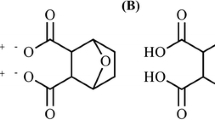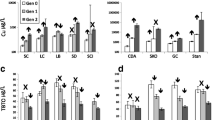Abstract
The goal of this study was to determine the influence of a range of salinities (5, 15, and 25 ppt) on the chronic toxicity of atrazine to the copepod, Eurytemora affinis during 8-day life-cycle tests. Survival, development (proportion of immature organisms) and reproduction (percent of egg-carrying females) were the endpoints used to determine chronic toxicity. Survival was the most sensitive endpoint and was therefore used to determine chronic values. The No Observed Effect Concentration (NOEC) and the Lowest Observed Effect Concentration (LOEC) at 5 ppt were 12.25 and 17.5 mg/L, respectively. The calculated chronic value was 14.6 mg/L. The NOEC and LOEC at 15 ppt were 17.5 and 25 mg/L, respectively, and the calculated chronic value at 15 ppt was 20.9 mg/L. The NOEC and LOEC at 25 ppt were 4.2 and 6.0 mg/L, respectively, while the calculated chronic value at 25 ppt was 5.01 mg/L. Results from a bootstrapping statistical technique demonstrated that there was a significant difference (p<0.05) between chronic values at 5 ppt (14.6 mg/L) and 25 ppt (5.01 mg/L), and between 15 ppt (20.9 mg/L) and 25 ppt (5.01 mg/L). There was no significant difference between chronic values at 5 ppt (14.6 mg/L) and 15 ppt (20.9 mg/L). These specific data for atrazine have important implications for development of estuarine water quality criteria, as toxicity test results at one salinity are not representative of the salinity range found in many estuaries.
Similar content being viewed by others
References
Ciba Geigy Corporation (1992) A review of surface-water monitoring for atrazine in the Chesapeake Bay watershed (1976–1991). Technical Report 3–92, Environmental Affairs Department, Greensboro, NC
Efron B (1982) The Jackknife, the Bootstrap, and other resampling plans. Society for Industrial and Applied Mathematics, Philadelphia, PA
Glotfelty DE, Taylor AW, Isensee AR, Tersey J, Glen S (1984) Atrazine and simazine movement to Wye River estuary. J Environ Qual 13:115–121
Guillard RRL (1975) Culture of phytoplankton for feeding marine invertebrates. In: Smith WL, Chanley MH (eds) Culture of Marine Invertebrate Animals. Plenum Publishing, NY, pp 29–60
Hall LW Jr, Anderson RD (1991) A review of estuarine aquatic toxicity data for the development of aquatic life criteria for atrazine in Chesapeake Bay. Report, Maryland Department of Environment, Baltimore, MD
Hall LW Jr (1993) An updated review of estuarine aquatic toxicity data for the development of aquatic life criteria for atrazine in Chesapeake Bay. Report, Maryland Department of Environment, Baltimore, MD
Hall LW Jr (1994) The influence of salinity on the toxicity of various classes of chemicals to aquatic biota. Report, Maryland Department of Environment, Baltimore, MD
Hall LW Jr, Ziegenfuss MC, Anderson RD, Lewis BL (1994c) The effect of salinity on the acute toxicity of total and free cadmium to the copepod, Eurytemora affinis and the larval fish, Cyprindon variegatus. Report, Maryland Department of Environment, Baltimore, MD
Hall LW Jr, Ziegenfuss MC, Anderson RD, Spittler TD, Leichtweis H. (1992) The effects of salinity on the degradation of atrazine. Report, Ciba Geigy Corporation, Greensboro, NC
Hall LW Jr (1994a) Influence of salinity on atrazine toxicity to a Chesapeake Bay copepod (Eurytemora affinis) and fish (Cyprinodon variegatus). Estuaries 17:181–186
Hall LW Jr (1994b) The influence of salinity on chronic toxicity of atrazine to an estuarine copepod: Filling a data need for development of an estuarine chronic criterion. Report, Ciba Geigy Corporation, Greensboro, NC
Hall LW Jr, Ziegenfuss MC, Fischer SA, Alden RW III, Gooch J, Debert-Hastings N (1991) A pilot study for ambient toxicity in Chesapeake Bay Volume I - Year 1. Report, U.S. Environmental Protection Agency, Chesapeake Bay Program, Annapolis, MD
Hershner C, Ward K, Illowsky J (1981) The effect of atrazine on Zostera marina in the Chesapeake Bay. Report, Virginia Institute of Marine Science, Gloucester Point, VA
Kosower EM (1968) An Introduction to Physical Organic Chemistry. John Wiley and Sons, NY, 503 pp
Lang DJ (1982) Water quality of three major tributaries to the Chesapeake Bay, the Susquehanna, Potomac and James Rivers. Report 82–32, U.S. Geological Survey, Towson, MD
McNamara PC (1991) Acute toxicity to the marine copepod (Acartia tonsa) under flow-through conditions. Report, Ciba Geigy Corporation, Greensboro, NC
Newby LC, Kahrs RA, Adams K, Szolics M (1978) Atrazine residues in the Chesapeake Bay. Paper, Presented at the Northeast Weed Science Society Meeting, Ciba Geigy Corporation, Greensboro, NC
Noreen EW (1989) Computer Intensive Methods for Testing Hypotheses. John Wiley and Sons, NY, 229 pp
Plumley FG, Davis DE (1980) The effects of a photosynthetic inhibitor, atrazine, on salt marsh adaphic algae in culture, microcosms, and in the field. Estuaries 3:217–223
SAS Institute Inc. (1989) SAS/STAT User's Guide, Version 6, Fourth Edition, Volume 2, SAS Institute, Cary, NC, 943 pp
Thursby G, Champlin D, Berry W (1990) Acute toxicity of atrazine to copepods. Preliminary Report, Science Applications Int. Corp., Narragansett, RI
USEPA (United States Environmental Protection Agency) (1991) Chesapeake Bay Toxics of Concern List Information Sheets. Report, USEPA, Chesapeake Bay Program, Annapolis, MD
Ward GS, Ballantine L (1985) Acute and chronic toxicity of atrazine to estuarine fauna. Estuaries 8:22–37
Author information
Authors and Affiliations
Rights and permissions
About this article
Cite this article
Hall, L.W., Ziegenfuss, M.C., Anderson, R.D. et al. The influence of salinity on the chronic toxicity of atrazine to an estuarine copepod: Implications for development of an estuarine chronic criterion. Arch. Environ. Contam. Toxicol. 28, 344–348 (1995). https://doi.org/10.1007/BF00213112
Received:
Revised:
Issue Date:
DOI: https://doi.org/10.1007/BF00213112




